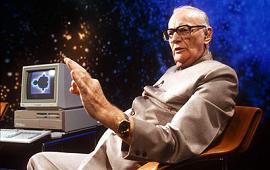National Geographic Magazine has an interesting article on some of the smart animals that are being used to learn about intelligence and cognition. Most people who have had a pet ‘know’ that animals can think because of the way that they react to us – they sometimes seem almost human.
But for a long time this idea was seriously out of fashion – experts agreed that people were projecting human emotions and thoughts onto animals (known as anthropomorphism). For instance at school I had a friend who claimed that her goldfish was embarrassed – surely a case of anthropomorphism.
However, the view that intelligence and emotions are purely human is simplistic and a little arrogant. Intelligence (and emotions) has obvious evolutionary advantages for social and long-lived animals. Humans are also just animals – we arrived through the same evolutionary processes. Isn’t it more plausible that there are levels of intelligence with some species showing more or less?
Plenty of scientists agree with me and have been working with animals to show that many of the qualities supposedly unique to human intelligence are shared by animals. The article goes into a lot of detail with awesome examples involving dogs, chimps, bonobos, parrots, jays, crows, dolphins and others. I thought that I would extract a few of the stories about clever animals.
 Alex the parrot was taught to pronounce English words and could understand several concepts. He was able to count, and distinguish shapes and colors. For instance when shown a group of toys and asked how many yellow ones there were he could tell you – ‘Five’. Alex even got impatient with other parrots who were getting their pronunciation wrong – calling out ‘Talk clearly!’ when they made mistakes.
Alex the parrot was taught to pronounce English words and could understand several concepts. He was able to count, and distinguish shapes and colors. For instance when shown a group of toys and asked how many yellow ones there were he could tell you – ‘Five’. Alex even got impatient with other parrots who were getting their pronunciation wrong – calling out ‘Talk clearly!’ when they made mistakes.
 Betsy the border collie understands more than 300 words and is able to learn new ones easily. One test involved putting several new toys (which Betsy had not seen before) in the kitchen. Betsy was then shown a picture of a Frisbee and told to fetch it from the kitchen. That she was able to do so shows that not only does she understand words like fetch and kitchen (something the testers already knew) but that she understands that a picture represents something in the real world.
Betsy the border collie understands more than 300 words and is able to learn new ones easily. One test involved putting several new toys (which Betsy had not seen before) in the kitchen. Betsy was then shown a picture of a Frisbee and told to fetch it from the kitchen. That she was able to do so shows that not only does she understand words like fetch and kitchen (something the testers already knew) but that she understands that a picture represents something in the real world.
 Betty the New Caledonian crow was able to create and use tools. In one test Betty was shown into a room in which there was a treat in a basket down a tube – out of her reach. There were also two pieces of wire in the room, one with a hook and one straight. The researchers had expected Betty to use the hooked wire to get the basket out, but another crow had already removed it….
Betty the New Caledonian crow was able to create and use tools. In one test Betty was shown into a room in which there was a treat in a basket down a tube – out of her reach. There were also two pieces of wire in the room, one with a hook and one straight. The researchers had expected Betty to use the hooked wire to get the basket out, but another crow had already removed it….
“Betty is undeterred. She looks at the meat in the basket, then spots the straight piece of wire. She picks it up with her beak, pushes one end into a crack in the floor, and uses her beak to bend the other end into a hook. Thus armed, she lifts the basket out of the tube.”
 When I was a teenager I used to enjoy testing my ability to hold me breath. My eventual record was 2 minutes and 8 seconds. I was pretty happy with that but I was aware that pros like Houdini and pearl divers could do that same for 4 or 5 minutes.
When I was a teenager I used to enjoy testing my ability to hold me breath. My eventual record was 2 minutes and 8 seconds. I was pretty happy with that but I was aware that pros like Houdini and pearl divers could do that same for 4 or 5 minutes.


 Arthur C. Clarke was a very well known science fiction writer who died on March 18 at 90 years old. The Economist always has superb obituary articles (probably my favorite section of the magazine) and this week the
Arthur C. Clarke was a very well known science fiction writer who died on March 18 at 90 years old. The Economist always has superb obituary articles (probably my favorite section of the magazine) and this week the 
